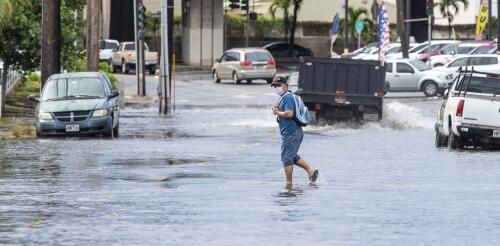US Supreme Court
Honolulu has lost more than 5 miles of its famous beaches to sea level rise and storm surges. Sunny-day flooding during high tides makes many city roads impassable, and water mains for the public drinking water system are corroding from saltwater because of sea level rise. The damage has left the city and county spending millions of dollars on repairs and infrastructure to try to adapt to the rising risks. Future costs will almost certainly be higher. More than US$19 billion in property value, at today’s dollars, is at risk by 2100 from projected sea level rise, driven by greenhouse gas emissions largely from the burning of fossil fuels. Elsewhere in Honolulu County, which covers all of Oahu, many coastal communities will be cut off or uninhabitable. Unwilling to have their taxpayers bear the full brunt of these costs, the city and county sued Sunoco LP, Exxon Mobil Corp. and other big oil companies in 2020. Their case – one of more than two dozen involving U.S. ci...
On May 11, 2023, the Biden administration proposed new regulations to curb carbon pollution from existing power plants. The new rules replace the Obama administration’s Clean Power Plan, which was proposed in 2015 but ran into multiple legal challenges and never took effect. Nonetheless, in a high-profile 2022 ruling, West Virginia v. EPA, the U.S. Supreme Court found that the Obama administration’s approach exceeded the Environmental Protection Agency’s authority to regulate power plant carbon pollution under the Clean Air Act. Jennifer K. Rushlow, dean of the Vermont School for the Environment and a law professor at Vermont Law & Graduate School, explains how the new regulations are designed and the delicate balance they attempt to strike between slowing climate change and avoiding further legal setbacks. 1. How has the Biden administration tailored these regulations in response to the West Virginia v. EPA ruling? The scent of West Virginia v. EPA is al...
Should California be able to require higher welfare standards for farm animals raised in other states if products from those animals are to be sold in California? On May 11, 2023, the U.S. Supreme Court upheld California’s position by a 5-4 vote in National Pork Producers Council v. Ross. While the ruling was fractured and reflected complex legal questions, it is a major victory for those working to improve farm animal welfare. A number of states will undoubtedly take advantage of the power that the Supreme Court has recognized. As a specialist in animal law, I expect that this will result in a patchwork of laws that are likely to make national meat producers very uncomfortable. Ultimately, it could push Congress to set federal standards. More indoor space for sows Pork producers sued California over a law that the state’s voters adopted in 2018 via ballot initiative with over 63% approval. It set new conditions for raising hogs, veal calves and egg-laying chicke...
Should Californians be able to require higher welfare standards for farm animals that are raised in other states if products from those animals are to be sold in California? The U.S. Supreme Court will confront that question when it hears oral argument in National Pork Producers Council v. Ross on Oct. 11, 2022. Pork producers are challenging a law that California voters adopted in 2018 via ballot initiative with over 63% approval. It set new conditions for raising hogs, veal calves and egg-laying chickens, whose meat or eggs are sold in California. The state represents about 15% of the U.S. pork market. At most commercial hog farms, pregnant sows are kept in “gestation crates” that measure 2 feet by 7 feet – enough room for the animals to sit, stand and lie down, but not enough to turn around. California’s law requires that each sow must have at least 24 square feet of floor space – nearly double the amount that most now get. It does not require f...
The U.S. Supreme Court opens its new session on Oct. 3, 2022, with a high-profile case that could fundamentally alter the federal government’s ability to address water pollution. Sackett v. EPA turns on a question that courts and regulators have struggled to answer for several decades: Which wetlands and bodies of water can the federal government regulate under the 1972 Clean Water Act? Under this keystone environmental law, federal agencies take the lead in regulating water pollution, while state and local governments regulate land use. Wetlands are areas where land is wet for all or part of the year, so they straddle this division of authority. Swamps, bogs, marshes and other wetlands provide valuable ecological services, such as filtering pollutants and soaking up floodwaters. Landowners must obtain permits to discharge dredged or fill material, such as dirt, sand or rock, in a protected wetland. This can be time-consuming and expensive, which is why the case is of keen...




